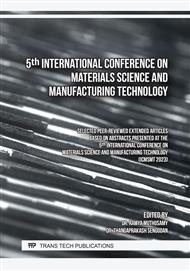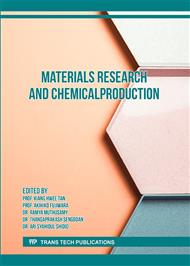[1]
A. Kosarac, C. Mladjenovic, M. Zeljkovic, S. Tabakovic, and M. Knezev, "Neural-Network-Based Approaches for Optimization of Machining Parameters Using Small Dataset," Materials (Basel)., vol. 15, no. 3, 2022.
DOI: 10.3390/ma15030700
Google Scholar
[2]
R. U. Baig, S. Javed, M. Khaisar, M. Shakoor, and P. Raja, "Development of an ANN model for prediction of tool wear in turning EN9 and EN24 steel alloy," Adv. Mech. Eng., vol. 13, no. 6, p.1–14, 2021.
DOI: 10.1177/16878140211026720
Google Scholar
[3]
S. Dahbi, L. Ezzine, and H. EL Moussami, "Modeling of cutting performances in turning process using artificial neural networks," Int. J. Eng. Bus. Manag., vol. 9, p.1–13, 2017.
DOI: 10.1177/1847979017718988
Google Scholar
[4]
S. Lakshmana Kumar, M. Thenmozhi, R. M. Bommi, C. Ezilarasan, V. Sivaraman, and S. Palani, "Surface Roughness Evaluation in Turning of Nimonic C263 Super Alloy Using 2D DWT Histogram Equalization," J. Nanomater., vol. 2022, 2022.
DOI: 10.1155/2022/9378487
Google Scholar
[5]
Y. V. Deshpande, A. B. Andhare, and P. M. Padole, "Application of ANN to estimate surface roughness using cutting parameters, force, sound and vibration in turning of Inconel 718," SN Appl. Sci., vol. 1, no. 1, p.1–9, 2019.
DOI: 10.1007/s42452-018-0098-4
Google Scholar
[6]
F. Boukezzi, R. Noureddine, A. Benamar, and F. Noureddine, "Modelling, prediction and analysis of surface roughness in turning process with carbide tool when cutting steel C38 using artificial neural network," Int. J. Ind. Syst. Eng., vol. 26, no. 4, p.567–583, 2017.
DOI: 10.1504/IJISE.2017.085227
Google Scholar
[7]
S. Al-Zubaidi, J. A. Ghani, and C. H. Che Haron, "Application of ANN in milling process: A review," Model. Simul. Eng., vol. 2011, 2011.
DOI: 10.1155/2011/696275
Google Scholar
[8]
V. Dilli Ganesh and R. M. Bommi, "'Prediction of Tool Wear by Using RGB Techniques in Comparison with Experimental Analysis,'" 2022 Int. Conf. Data Sci. Agents Artif. Intell. (ICDSAAI), Chennai, India, 2022, pp., 2022.
DOI: 10.1109/icdsaai55433.2022.10028899
Google Scholar
[9]
S. O. Sada and S. C. Ikpeseni, "Evaluation of ANN and ANFIS modeling ability in the prediction of AISI 1050 steel machining performance," Heliyon, vol. 7, no. 2, p. e06136, 2021.
DOI: 10.1016/j.heliyon.2021.e06136
Google Scholar
[10]
U. M. R. Paturi, S. Cheruku, V. P. K. Pasunuri, S. Salike, N. S. Reddy, and S. Cheruku, "Machine learning and statistical approach in modeling and optimization of surface roughness in wire electrical discharge machining," Mach. Learn. with Appl., vol. 6, no. May, p.100099, 2021.
DOI: 10.1016/j.mlwa.2021.100099
Google Scholar
[11]
R. M. Bommi, C. Ezilarasan, M. P. Sudeshkumar, and T. Vinoth, "Estimation of Flank Wear in Turning of Nimonic C263 Super Alloy Based on Novel MSER Algorithm and Deep Patten Network," Russ. J. Nondestruct. Test., vol. 58, no. 2, p.140–156, 2022.
DOI: 10.1134/S1061830922020073
Google Scholar
[12]
Y. M. Arisoy and T. Özel, "Machine learning based predictive modeling of machining induced microhardness and grain size in Ti-6Al-4V alloy," Mater. Manuf. Process., vol. 30, no. 4, p.425–433, 2015.
DOI: 10.1080/10426914.2014.961476
Google Scholar
[13]
A. H. Elsheikh et al., "Fine-tuned artificial intelligence model using pigeon optimizer for prediction of residual stresses during turning of Inconel 718," J. Mater. Res. Technol., vol. 15, p.3622–3634, 2021.
DOI: 10.1016/j.jmrt.2021.09.119
Google Scholar
[14]
B. Bhandari, "Comparative study of popular deep learning models for machining roughness classification using sound and force signals," Micromachines, vol. 12, no. 12, 2021.
DOI: 10.3390/mi12121484
Google Scholar
[15]
V. H. Nguyen et al., "Applying Bayesian Optimization for Machine Learning Models in Predicting the Surface Roughness in Single-Point Diamond Turning Polycarbonate," Math. Probl. Eng., vol. 2021, 2021.
DOI: 10.1155/2021/6815802
Google Scholar



